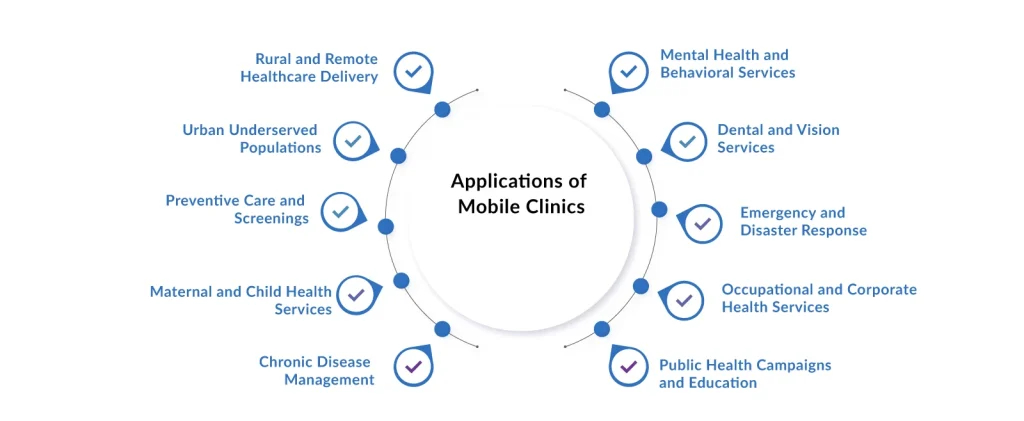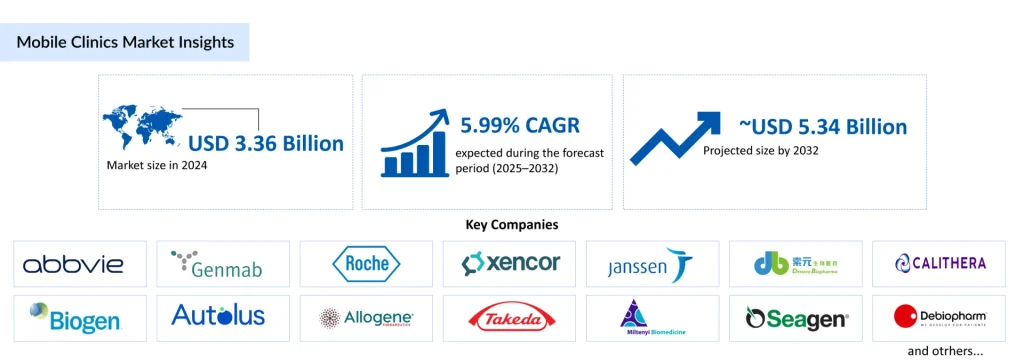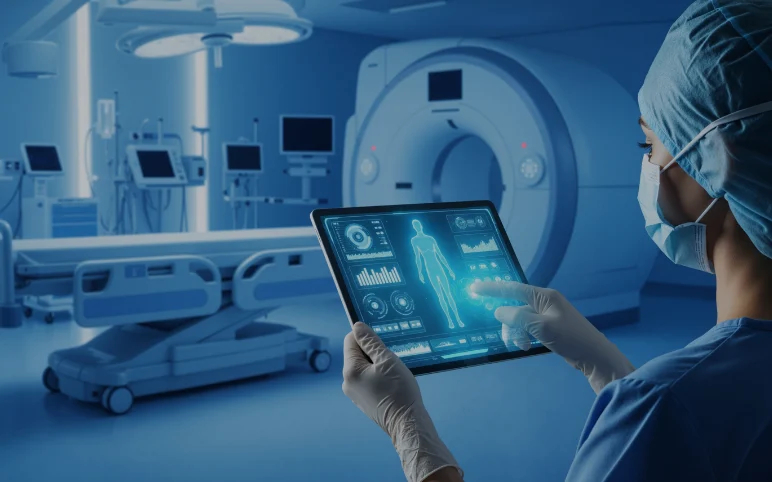10 Powerful Applications of Mobile Clinics Around the World Bridging the Healthcare Gap
Aug 27, 2025
Table of Contents
In a world where access to healthcare can mean the difference between life and death, mobile clinics are revolutionizing the delivery of medical services. A fully equipped van rolling into a remote village, transforming a dusty parking lot into a bustling hub of hope and healing. These “healthcare on wheels” units are not just vehicles; they’re lifelines, bridging gaps in traditional systems and driving health forward with innovation and empathy. From bustling cities to isolated outposts, mobile health clinics are proving that quality care doesn’t have to be stationary.
What Are Mobile Clinics?
At their core, mobile clinics are specialized vehicles, ranging from vans and buses to trailers and even boats, outfitted with medical equipment, diagnostic tools, and treatment spaces to provide on-the-go healthcare. Think of them as mini-hospitals on the move, capable of offering everything from basic check-ups to specialized services like X-rays or lab testing. Unlike fixed facilities, these mobile health clinics adapt to the needs of diverse populations, deploying where demand is highest. For instance, a mobile vet clinic might focus on animal health in rural farming communities, ensuring livestock and pets receive timely care without long journeys—though our spotlight here remains on human health innovations.
Downloads
Click Here To Get the Article in PDF
Recent Articles
- Zimmer Biomet Secures Japan PMDA Approval for First Iodine-Treated Total Hip Replacement System; ...
- Geneseeq Technology Inc.’s GENESEEQPRIME® Assay Receives FDA 510(k) Clearance; Medtronic’s MiniMe...
- How the Amniotic Membrane Market is Transforming Regenerative Healthcare Worldwide
- Neurovascular Thrombectomy Devices Market
- Asahi Intecc Partners with Penumbra; Prosoma and EVERSANA Announce Commercialisation Partnership;...
To gain a thorough understanding of what mobile clinics are, their impact, and innovations, click here to read the blog, curated explicitly for this purpose.
Why They Matter in Today’s Healthcare Landscape
In an era marked by pandemics, climate crises, and widening inequalities, mobile clinics stand out as agile solutions that extend the reach of healthcare beyond brick-and-mortar walls. They tackle barriers such as geography, cost, and infrastructure, making services accessible to millions who might otherwise be unable to access them.
According to the World Health Organization (WHO), mobile health clinics have played a pivotal role in expanding primary care in low-resource settings. Recent initiatives, such as their 2023 emergency response programs in conflict zones, have delivered vaccinations to over 1 million people.
Governments and companies are investing heavily; for example, the U.S. Department of Health and Human Services (HHS) launched expanded funding in 2024 for mobile clinic fleets to combat opioid crises in rural America, highlighting their role in rapid, targeted interventions. These breakthroughs underscore how mobile clinics not only save lives but also foster healthier, more resilient communities worldwide. Let’s explore 10 powerful applications where mobile clinics are redefining healthcare delivery and bringing hospitals closer to patients.

1. Rural and Remote Healthcare Delivery
In the vast expanses where roads fade into horizons and hospitals are mere myths, mobile clinics emerge as beacons of hope, delivering essential healthcare directly to the doorsteps of isolated communities. These mobile health clinics navigate rugged terrains and cultural barriers, ensuring that geography no longer dictates wellness. Equipped with diagnostic tools, medications, and skilled professionals, they provide immediate care, from routine consultations to emergency interventions, transforming remote areas into zones of proactive health management.
Reaching Patients in Isolated or Underserved Areas
Mobile clinics excel in bridging the chasm between urban medical hubs and rural outposts, where fixed facilities are scarce or inaccessible. By deploying to underserved regions, they reduce travel burdens, lower costs for patients, and increase service uptake. Recent advancements, such as integrating AI for diagnostics, have amplified their impact—allowing real-time data analysis and personalized care even in off-grid locations. For instance, governments are leveraging these units to combat disparities, with initiatives focusing on equitable access through scheduled rotations and community partnerships.
Mobile Clinics in Rural India and Sub-Saharan Africa
In rural India, the National Health Mission’s Mobile Medical Units (MMUs) have been pivotal, with AI-driven mobile health clinics introduced in late 2024 to enhance rural outreach, blending technology with on-ground expertise for efficient service delivery. These units have facilitated preventive and curative care, reaching millions in hard-to-access areas under schemes like Ayushman Bharat. Meanwhile, in Sub-Saharan Africa, WHO-supported mobile clinics in countries such as Madagascar have made significant strides since 2022, with 20 units enabling over one million people to access curative services in remote areas, thereby significantly filling healthcare gaps. In Niger, similar efforts have enhanced access to maternal and general health services, demonstrating how these clinics adapt to local needs for sustainable impact.
2. Urban Underserved Populations
In the shadows of skyscrapers and amid the hustle of city life, mobile clinics shine as vital allies, delivering compassionate care to those overlooked by traditional healthcare systems. These mobile health clinics navigate urban mazes to serve populations facing barriers such as poverty, housing instability, and systemic inequities, ensuring that no one is left behind in the pursuit of wellness.
Addressing Gaps in Inner-City Healthcare Access
Mobile clinics fill critical voids in urban healthcare by bringing services directly to high-need neighborhoods, where overcrowded facilities and transportation hurdles often deter access. They offer flexible scheduling, multilingual support, and integrated social services, making healthcare approachable and effective. Recent U.S. Department of Health and Human Services (HHS) initiatives, as outlined in their 2024 report, emphasize mobile care and outreach to enhance accessibility for vulnerable groups, leading to improved health outcomes and reduced emergency room visits.
Homeless Outreach and Marginalized Communities
For individuals experiencing homelessness or belonging to marginalized groups, mobile health clinics provide street-level outreach, offering everything from wound care to mental health screenings without the need for appointments or insurance. These units build trust through consistent presence, addressing immediate needs while connecting people to long-term resources. A 2024 study highlighted how street medicine and mobile programs have boosted healthcare access and favorable outcomes for these populations, underscoring their role in equity-driven care. While our focus remains on human health, it’s worth noting that mobile vet clinics often complement these efforts in urban settings, providing on-site care for pets of homeless individuals, which supports emotional well-being and encourages engagement with broader health services.
3. Preventive Care and Screenings
Mobile clinics are proactive powerhouses, rolling out preventive measures that catch health issues early and empower communities with knowledge. By taking vaccinations, screenings, and check-ups to the people, these mobile health clinics turn potential crises into manageable moments, fostering a culture of prevention over cure.
Vaccination Drives, Cancer Screenings, and Regular Check-Ups
From flu shots to full-body assessments, mobile units streamline preventive services, making them convenient and stigma-free. They host vaccination campaigns in community hubs and conduct on-the-spot screenings for cancers like cervical or breast cancer, often using portable tech for quick results. The World Health Organization (WHO) reported in 2025 that global efforts, including HPV vaccination drives, are accelerating cervical cancer elimination through widespread screening and immunization programs.
How Mobile Units Promote Early Detection
By emphasizing early intervention, mobile clinics enhance survival rates and reduce treatment costs through timely diagnostics. Their mobility enables targeted campaigns in high-risk areas, integrating education to enhance awareness. Recent CDC insights from 2025 highlight how HPV vaccination at young ages, combined with screening initiatives, effectively prevents cervical cancer, with one-dose vaccines showing 80-90% efficacy in reducing infections.
4. Maternal and Child Health Services
Mobile clinics cradle the future by safeguarding mothers and children, delivering specialized care that nurtures new life from conception through early childhood. These mobile health clinics adapt to cultural contexts, ensuring safe pregnancies and healthy starts in even the most challenging environments.
Prenatal Care, Immunizations, and Postnatal Support
Offering comprehensive packages, mobile units provide prenatal check-ups, immunizations, and postnatal guidance all in one visit, maximizing convenience. They equip families with nutrition advice and monitor developmental milestones, building a foundation for lifelong health. UNICEF’s work in Mali utilizes mobile clinics for prenatal services, child illness treatment, and vaccinations, directly supporting maternal and child well-being.
Reducing Maternal Mortality in Low-Income Regions
In regions where maternal deaths are alarmingly high, mobile clinics intervene with emergency referrals and skilled birth attendants, dramatically lowering risks. They focus on preventable complications through education and access. WHO’s 2025 efforts, including mobile clinics in humanitarian crises such as those in Syria and Sudan, have been crucial in providing maternity care and reducing preventable maternal deaths. In Niger, WHO-supported mobile clinics have significantly improved access to maternal health services, contributing to reductions in maternal mortality.
5. Chronic Disease Management
Mobile clinics help maintain the rhythm of life for those battling ongoing conditions, providing continuous support that adapts to daily realities. These mobile health clinics transform management into mobility, enabling patients to maintain control over diseases like diabetes and hypertension wherever they are.
Diabetes, Hypertension, and Asthma Care on the Go
With portable monitoring devices and medication dispensing, mobile units offer tailored check-ins, adjustments, and education for individuals with chronic conditions. They enable frequent touchpoints without disrupting routines, improving adherence and outcomes. In 2024, the Centers for Disease Control and Prevention (CDC) emphasized the use of telehealth and mobile interventions to improve chronic disease control, including hypertension management.
Integrating Mobile EHR and Remote Monitoring
By incorporating electronic health records (EHR) and remote tools, mobile clinics ensure seamless data sharing and real-time oversight, allowing for proactive adjustments. This tech integration enhances patient engagement and reduces hospitalizations. WHO’s mHealth initiatives support remote monitoring for conditions like diabetes and asthma, facilitating effective chronic care in diverse settings.
6. Mental Health and Behavioral Services
Mobile clinics are breaking down the walls of stigma and inaccessibility, delivering compassionate mental health support right where it’s needed most. These mobile health clinics equip teams with tools for counseling, crisis intervention, and medication management, turning vehicles into safe spaces for healing and hope in a world grappling with rising psychological demands.
Mobile Psychiatry and Counseling Units
These specialized units offer on-site therapy sessions, psychiatric evaluations, and follow-up care, making mental health services as mobile as modern life. They cater to diverse needs, from anxiety to severe disorders, with privacy and immediacy at the forefront. In March 2025, New Season launched a mobile clinic in Portland, providing substance-use treatment like buprenorphine and methadone to homeless individuals, directly addressing barriers in the opioid crisis.
Tackling the Mental Health Crisis in Schools and Communities
By embedding in educational settings and neighborhoods, mobile clinics foster early intervention and community resilience, educating while treating. They combat isolation through group sessions and outreach. The World Health Organization (WHO) emphasized in July 2025 that community-based mental health care, including mobile services, helps reduce isolation and supports inclusion in both emergencies and daily life. Similarly, in April 2025, the U.S. Department of Health and Human Services (HHS) highlighted the integration of telehealth services in rural schools to support mental health, specifically aiding students with stress and depression.
7. Dental and Vision Services
Rolling into communities with precision and care, mobile clinics brighten smiles and sharpen sights, addressing often-overlooked aspects of health that impact daily living and confidence. These mobile health clinics bring professional dental and optical services to the underserved, preventing minor issues from escalating into major hurdles.
Mobile Dental Clinics in Schools and Workplaces
Equipped with chairs, X-ray machines, and sterilization tools, these units provide on-site cleanings, fillings, and extractions, minimizing disruptions to education or work. In January 2025, Medical Teams International launched two new mobile clinics with dental operatories to deliver preventive and urgent care in the Pacific Northwest’s underserved areas.
Addressing Vision Care in Underserved Populations
Mobile vision services offer screenings, prescriptions, and glasses distribution, enhancing the quality of life for those in remote or low-income zones. The WHO’s 2025 regional framework for oral health, which extends principles to integrated care, emphasizes workforce development in underserved areas, while eye care plans, such as the South-East Asia Regional Action Plan 2022–2030, promote mobile outreach to address vision needs.
8. Emergency and Disaster Response
When crises strike, mobile clinics surge forward as first responders, deploying swiftly to deliver life-saving care amid chaos. These mobile health clinics adapt to fluid situations, from earthquakes to conflicts, ensuring continuity of health services when traditional infrastructure crumbles.
Rapid Deployment in Natural Disasters, Conflicts, or Pandemics
Their agility enables quick setup in affected zones, allowing for triage, vaccinations, and basic surgeries. In May 2025, a repurposed popemobile was transformed into a mobile health clinic for children in Gaza, offering emergency care amid war-induced healthcare collapse. WHO’s 2025 operational updates highlight mobile clinics treating over 123,600 patients in conflict-affected states.
Mobile ICUs and Field Clinics
Equipped with intensive care capabilities, including ventilators and monitoring, these units serve as portable hospitals. Samsung India’s 2025 launch of AI-powered mobile CT scanners, such as CereTom Elite, brings advanced imaging to emergency settings, enhancing diagnostics in regions with limited infrastructure.
9. Occupational and Corporate Health Services
Mobile clinics accelerate workplace wellness, offering convenient screenings and programs that promote employee health and productivity. These mobile health clinics partner with businesses to prevent occupational hazards, blending health with corporate efficiency for a thriving workforce.
Workplace Health Screenings and Wellness Programs
From blood pressure checks to ergonomic assessments, these services promote early detection and lifestyle education at job sites. The Centers for Disease Control and Prevention (CDC)’s updated 2025 Worksite Health ScoreCard manual guides employers on implementing screenings to assess and improve health initiatives.
Improving Employee Health and Reducing Downtime
By addressing on-site issues like respiratory conditions, mobile units minimize absences and boost morale. In February 2025, the CDC’s Coal Workers’ Health Surveillance Program expanded mobile screenings for black lung, offering free exams and histories to miners, enhancing occupational safety.
10. Public Health Campaigns and Education
Mobile clinics accelerate awareness on wheels, transforming public spaces into classrooms for health literacy and prevention. These mobile health clinics amplify campaigns, partnering locally to empower communities with knowledge that prevents disease and promotes well-being.
Health Literacy, Awareness Drives, and Disease Prevention
Through interactive sessions and materials, they educate on topics like nutrition and hygiene, fostering informed choices. UNICEF’s 2025 guide on digital tools for health campaigns integrates mobile clinics for outreach, enhancing education in remote areas. WHO’s efforts in Viet Nam, reported in July 2025, used mobile services to achieve near-zero leprosy through prevention and education.
Partnering with Local Organizations for Greater Impact
Collaborations extend reach, combining resources for sustained campaigns. In June 2025, Aster Volunteers launched mobile units in Gujarat, partnering with local organizations to deliver essential services and education to rural villages. CDC’s 2025 Partnering for Vaccine Equity program utilized mobile clinics for education and access, boosting community engagement.
Market Outlook for Mobile Clinics
The mobile clinics market was valued at USD 3,362.50 million in 2024 and is projected to grow at a CAGR of 5.99% from 2025 to 2032, reaching USD 5,338.17 million by 2032. This steady rise is being fueled by widening healthcare access gaps in underserved regions, the growing burden of acute and chronic diseases, and the increasing recognition of mobile healthcare as a cost-efficient and flexible solution. North America is expected to retain its dominance due to advanced infrastructure, supportive policies, and strong adoption across both rural and urban underserved populations. Meanwhile, emerging economies in the Asia-Pacific and Africa are likely to witness the fastest growth as governments and NGOs scale community-based care initiatives.

Driving this market forward are collaborations among healthcare providers, governments, and innovators, alongside the contributions of key players such as Armor Mobile Systems, ADI, Matthews Specialty Vehicles, Odulair, Farber Specialty Vehicles, LifeLine Mobile, Johnson Medical International, Kentucky Trailer, La Boit Specialty Vehicles, MinFound Medical Systems, EMS Healthcare, Winnebago Industries, LDV, and others. Together, these companies are not only expanding their fleets but also reimagining mobile healthcare through technology integration, sustainable designs, and patient-centered models, signaling that the future of healthcare will be increasingly mobile, inclusive, and adaptable.
Challenges and Considerations
While mobile clinics propel healthcare into new territories, they navigate a landscape riddled with obstacles that demand strategic foresight and collaborative resolve. These mobile health clinics, although innovative, face systemic barriers that can hinder their full potential, ranging from resource constraints to the need for seamless integration within broader health ecosystems. Addressing these head-on is essential to harnessing their transformative power effectively.
Funding, Staffing, and Logistical Hurdles
Securing consistent funding remains a core challenge, with high startup costs for vehicles and equipment, often ranging from $300,000 to $500,000, compounded by inadequate reimbursement rates from sources such as Medicaid, leading to a heavy reliance on grants and philanthropy. Staffing shortages exacerbate this issue, particularly in behavioral health and rural areas, where workforce burnout rates among physicians hover around 48%, and hiring is hindered by tight job markets, travel demands, and competition for skilled professionals such as nurses and doctors.
Logistically, vehicle maintenance, space limitations, and regulatory hurdles, such as daily returns to base sites, restrict operational range. Additionally, conflict zones pose security risks and supply chain disruptions, as seen in humanitarian responses, where only 40% of the 2024 health sector needs were funded.
Sustainability and Long-Term Integration with Health Systems
Ensuring long-term viability requires overcoming donor dependency and integrating mobile units into national health frameworks, such as through fee-for-service models or capitation adjustments, to avoid service overlaps and promote cost-effectiveness—evident in evaluations where per-consultation costs reach about US$9.35 in outreach settings. Climate change and prolonged crises further strain sustainability, necessitating resilient designs, such as solar-powered facilities. Full integration, however, demands robust data systems for monitoring and policy alignment, to prevent brain drain and enhance continuity of care in evolving landscapes.
The Final Stop: Driving Healthcare Forward
As mobile health clinics accelerate toward a more inclusive global health paradigm, scaling innovations like AI-driven diagnostics and expanded telehealth integrations promise to amplify their reach, empowering underserved regions with equitable, adaptive solutions that not only bridge immediate gaps but also pave sustainable pathways for resilient systems, ultimately redefining healthcare’s boundaries with precision and purpose.

Downloads
Article in PDF
Recent Articles
- Artica Systems’s Electric Whole-Body Cryotherapy Machines; Nevro’s Revolutionary HFX iQ™ S...
- Apyx Medical Received FDA 510(k) Clearance for the Use of Renuvion; Medtronic’s Next-generation M...
- Genesis Medtech Secures Chinese Approval for Innovative 90° Articulating Stapler; Inogen Secures ...
- Scanogen’s Bloodstream Infection Assay Earns FDA Breakthrough Device Status; Lapsi Health Launche...
- Laborie’s Enhanced Gastrointestinal Diagnostics; Carestream’s Image Suite MR 10 Software Launch; ...



